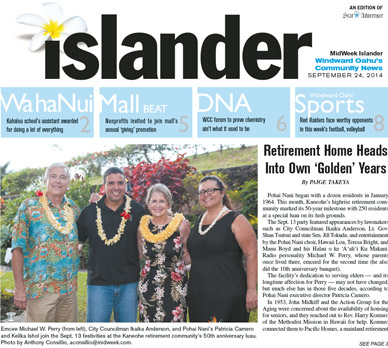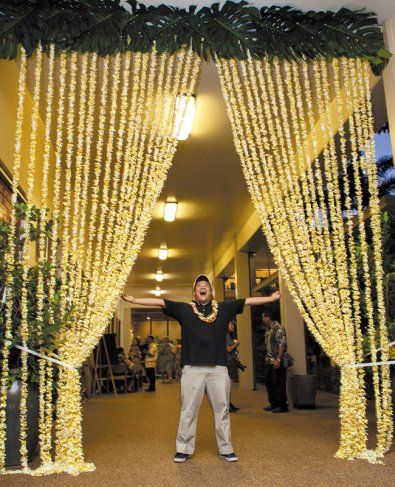Retirement Home Heads Into Own ‘Golden’ Years
Pohai Nani began with a dozen residents in January 1964. This month, Kaneohe’s highrise retirement community marked its 50-year milestone with 250 residents at a special luau on its lush grounds.
The Sept. 13 party featured appearances by lawmakers such as City Councilman Ikaika Anderson, Lt. Gov. Shan Tsutsui and state Sen. Jill Tokuda; and entertainment by the Pohai Nani choir, Hawaii Loa, Teresa Bright, and Manu Boyd and his Halau o ke ‘A’ali’i Ku Makani. Radio personality Michael W. Perry, whose parents once lived there, emceed for the second time (he also did the 10th anniversary banquet).
ww-092414-pohai-nani-50th-ac-2
The facility’s dedication to serving elders — and its longtime affection for Perry — may not have changed, but much else has in those five decades, according to Pohai Nani executive director Patricia Camero.
In 1953, John Midkiff and the Action Group for the Aging were concerned about the availability of housing for seniors, and they reached out to Rev. Harry Komuro of the Methodist Mission in Hawaii for help. Komuro connected them to Pacific Homes, a mainland retirement and care facility corporation, which agreed to help them establish a retirement home in Hawaii.
The newly founded Hawaii Pacific Homes selected a 16-acre site in Kaneohe and named it Pohai Nani, (“surrounded by beauty”), as suggested by Hawaiian scholar and kumu hula Mary Kawena Pukui. Back in 1963, prospective residents had to pass a rigid physical examination, be at least 60 years old and pay a lifetime lease, ranging from $7,800 to $28,000, before moving in.
After Pacific Homes filed for bankruptcy, the South Dakota-based Evangelical Lutheran Good Samaritan Society purchased Pohai Nani in 1980.
“Our corporate office is very involved in health care on a national level,” explained Camero. “They keep the pulse of where health care is going and the pulse of senior retirement needs into the future; Pohai Nani keeps the pulse of what’s happening locally. When it comes together, it’s very powerful.” She said that the Society allows its Hawaii branch “much freedom” to operate, allowing Camero and her staff to “put our Hawaiian spin and our Pohai Nani modification to the day-to-day activities around our campus.”
What this translates to is a dedication to community, with its residents eager to look outside their walls to help and work with others. “Sometimes I run into people who think of us as the old folks’ home, but this is a vibrant community of people who are very much involved in all aspects of community life,” said Chaplain Ruth Peterson, who spearheads Pohai Nani’s adopt-a-grandparent program with Seagull Schools.
Numerous clubs and organizations use Pohai Nani facilities for meetings, Camero noted, including Kaneohe Rotary Club, Kaneohe Business Group and Windward Readers Theatre.
“One thing I love to see happening is having Pohai Nani also serve as an educational and training site for HPU and University of Hawaii nursing students, HPU practicum site for social work students, as well as chaplain interns with Pacific Health Ministry.
“Just because you retire from a job … doesn’t mean you retire from life,” Camero pointed out. And as Pohai Nani enters its next 50 years, don’t expect that attitude to change.
For more information on Pohai Nani and its services, call 247-6211.







